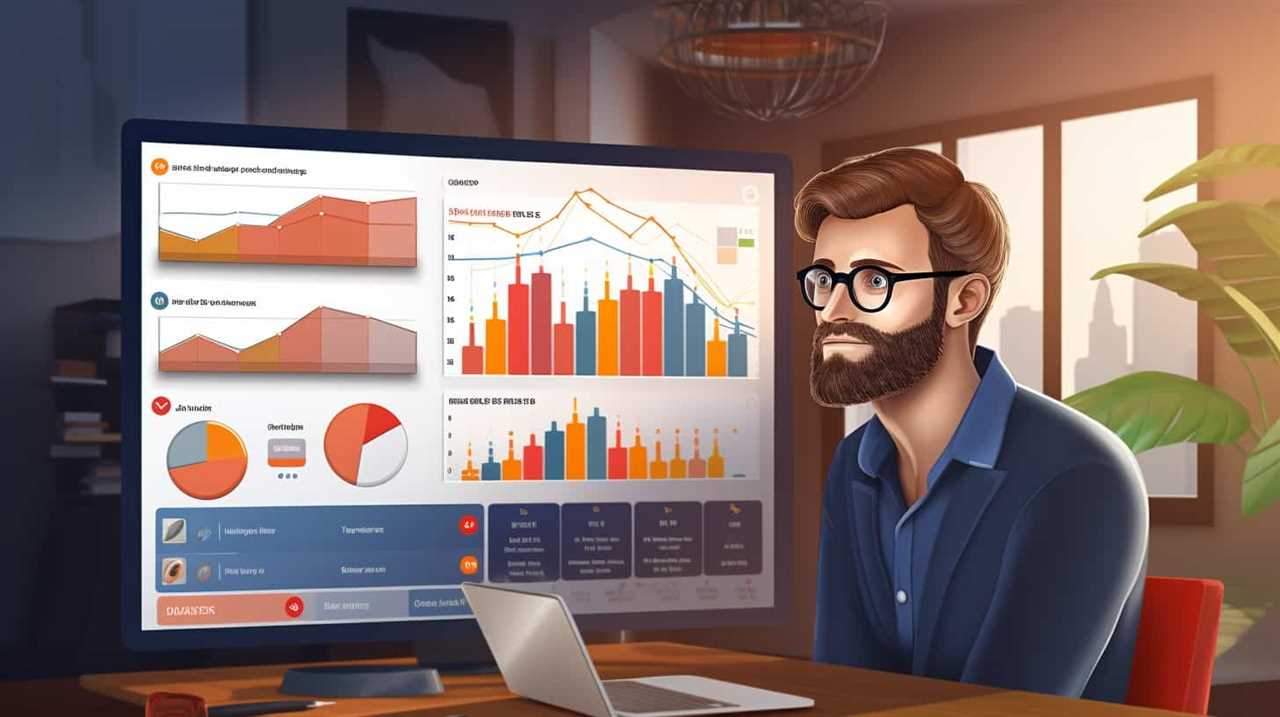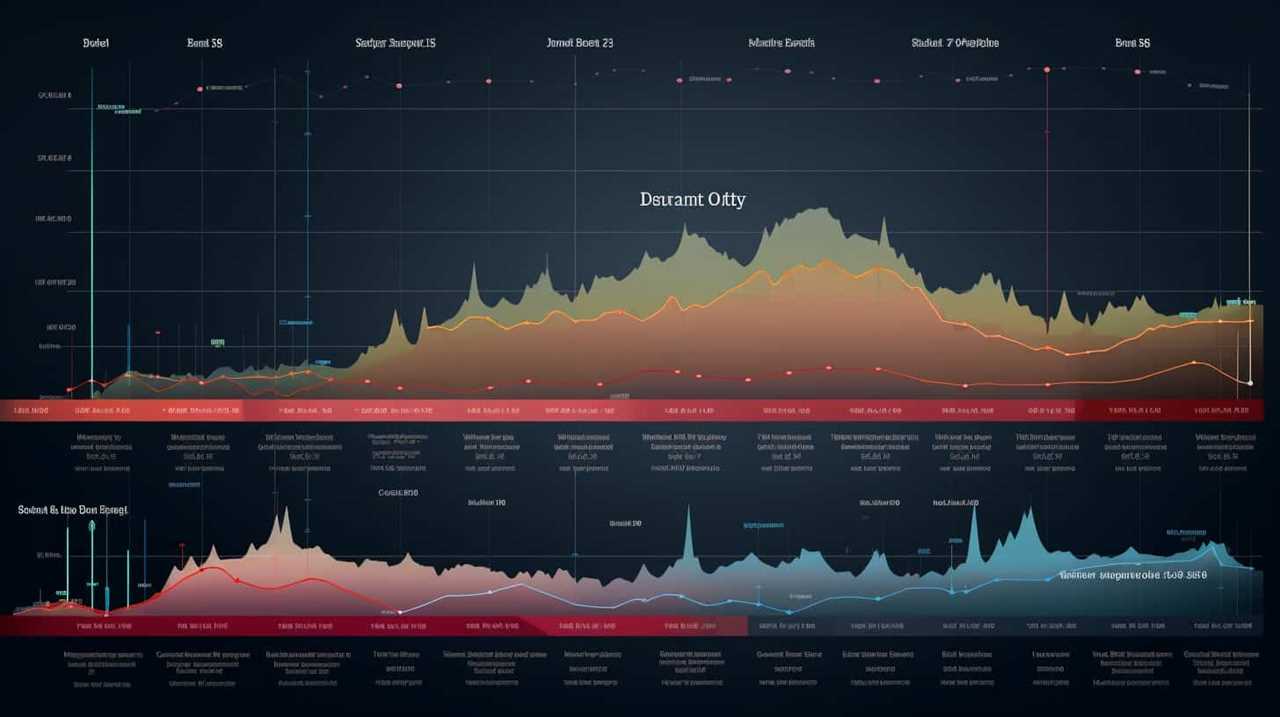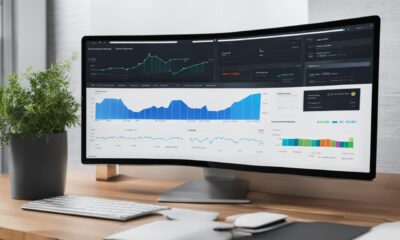Holistic SEO
Why Do We Do Technical Seo

We deploy technical SEO techniques to enhance our website’s presence, boost our positions in search engine outcomes, and grow our natural website traffic.
By optimizing our website’s structure and architecture, we enhance user experience and satisfaction. We fix technical errors and issues, ensuring our website is compatible with search engine algorithms.
We also optimize our website for mobile devices, gaining a competitive edge in the digital landscape.
In short, technical SEO enables us to master the art of online visibility and drive success.

Key Takeaways
- Technical SEO enhances website visibility and improves search engine rankings.
- Keyword research and optimization drive organic traffic and increase website rankings.
- Content optimization strategies create engaging and valuable website content, driving organic traffic.
- Website performance and user experience are crucial for improved search engine rankings and conversions.
Enhancing Website Visibility
To enhance our website visibility, we focus on optimizing technical SEO through a combination of strategic keyword research and effective meta tag implementation.
By improving website accessibility, we ensure that our site is easily navigable for all users, including those with disabilities. This includes incorporating alt text for images, providing clear headings and subheadings, and optimizing page loading times.
We also prioritize maximizing website conversions by creating compelling calls-to-action, optimizing landing pages, and streamlining the checkout process.
Through continuous data analysis and A/B testing, we identify areas for improvement and make data-driven decisions to enhance the user experience and increase conversion rates.

Improving Search Engine Rankings
When it comes to improving search engine rankings, there are two key points to consider: keyword optimization techniques and backlink building strategies.
By strategically incorporating relevant keywords into your website content and meta tags, you can increase your chances of ranking higher in search engine results.
Additionally, building high-quality backlinks from authoritative websites can also help improve your website’s visibility and credibility in the eyes of search engines.
Keyword Optimization Techniques
Keyword optimization techniques play a crucial role in improving our search engine rankings. To achieve success in this area, we must focus on two key aspects:

- On-page optimization techniques: This involves optimizing our website’s content, such as using relevant keywords in our meta tags, headlines, and body text. Additionally, we need to ensure our website is properly structured with user-friendly URLs, informative alt tags for images, and optimized internal linking.
- Off-page optimization strategies: These strategies involve building high-quality backlinks from authoritative websites. This can be achieved through guest blogging, influencer outreach, and social media promotion. By obtaining backlinks from reputable sources, we can increase our website’s credibility and visibility in search engine rankings.
With these keyword optimization techniques in place, we can effectively enhance our website’s visibility and organic traffic.
Now, let’s explore the next section on backlink building strategies.
Backlink Building Strategies
After implementing effective keyword optimization techniques, we can now delve into backlink building strategies to further improve our search engine rankings.
Building high-quality backlinks is crucial for increasing our website’s visibility and authority in the eyes of search engines. To achieve this, we need to focus on implementing proven link building techniques and effective outreach strategies.

One effective approach is to identify authoritative websites in our niche and reach out to them for collaboration or guest posting opportunities.
Another strategy is to create valuable and shareable content that naturally attracts backlinks from other websites.
Additionally, participating in industry forums and online communities can help us build relationships and gain backlinks from trusted sources.
Increasing Organic Website Traffic
To increase organic website traffic, we need to implement SEO best practices, such as optimizing our website for search engines.

This includes conducting keyword research to identify the most relevant and high-performing keywords to target in our content.
SEO Best Practices
Improving website traffic organically is achieved by implementing SEO best practices.
To increase organic website traffic, it’s crucial to conduct regular SEO audits to identify areas for improvement. These audits help uncover technical issues and optimize website performance.
On-page optimization is another essential SEO best practice that focuses on optimizing individual web pages to rank higher in search engine results. This involves optimizing meta tags, header tags, and keyword usage to make the content more accessible and relevant to search engines.

Additionally, it’s important to prioritize user experience by improving website speed, enhancing mobile responsiveness, and optimizing site navigation.
Keyword Research Importance
Keyword research is essential for increasing organic website traffic and is a crucial step in our technical SEO process. By conducting thorough keyword research, we can identify the most relevant and high-performing keywords that our target audience is searching for. This allows us to optimize our website content and improve its visibility in search engine results.
In addition to targeting broad keywords, we also focus on long tail keywords, which are longer and more specific keyword phrases. These long tail keywords often have lower search volume but higher conversion rates, making them valuable for driving targeted traffic to our website.
Furthermore, competitive analysis helps us understand which keywords our competitors are targeting and allows us to find opportunities to outperform them. By incorporating long tail keywords and leveraging competitive analysis, we can significantly increase our organic website traffic.

Now, let’s explore content optimization strategies to further enhance our SEO efforts.
Content Optimization Strategies
Our approach to content optimization is to focus on creating engaging and valuable website content that drives organic traffic. By following effective content creation and on-page optimization strategies, we aim to increase the visibility and relevance of our website in search engine results.
Here are two key strategies we employ:
- Keyword research: We conduct thorough keyword research to identify relevant and high-performing keywords that align with our target audience’s search intent. This helps us optimize our content by incorporating these keywords strategically in the title, headings, meta tags, and body text.
- User-centric approach: We prioritize user experience by creating content that provides value, answers their questions, and addresses their pain points. This includes using clear and concise language, organizing content with headings and bullet points, and incorporating multimedia elements like images and videos.
Optimizing Website Structure and Architecture
To enhance the performance of our website, we streamline its structure and architecture through optimizing. One crucial aspect of this optimization process is improving the website navigation, which involves creating a clear and intuitive menu structure that allows users to easily find the information they are looking for. Another important factor is the URL structure, which should be concise, descriptive, and keyword-rich to enhance search engine visibility.

To visualize the impact of optimizing website structure and architecture, consider the following table:
| Before Optimization | After Optimization |
|---|---|
| Complex navigation | Simplified navigation |
| Lengthy and unclear URLs | Short and keyword-rich URLs |
| Confusing site hierarchy | Clear and logical site hierarchy |
Enhancing User Experience and Satisfaction
To enhance user experience and satisfaction, we focus on two key factors: page loading speed and mobile-friendly design.
Studies show that slow loading speeds can significantly impact user engagement, with a one-second delay resulting in a 7% reduction in conversions. By optimizing website performance and ensuring quick loading times, we can create a seamless browsing experience that keeps users engaged and satisfied.
Additionally, with the increasing use of mobile devices, having a mobile-friendly design is crucial to providing a positive user experience, as it allows visitors to easily navigate and interact with the website on smaller screens.

Page Loading Speed
Improving page loading speed enhances user experience and satisfaction by reducing wait times. When users visit a website, they expect instant access to its content. Slow loading pages can lead to frustration and abandonment, resulting in a poor user experience. By focusing on page loading speed, we can improve navigation experience and keep users engaged.
To enhance page loading speed, two key factors need to be addressed:
- Optimizing website elements: By compressing images, minifying CSS and JavaScript files, and reducing the number of HTTP requests, we can minimize the file size and load time of a webpage.
- Minimizing server response time: A fast server response time ensures that users can quickly access the requested content. This can be achieved by optimizing server configurations, reducing database queries, and leveraging caching mechanisms.
Mobile-Friendly Design
We frequently prioritize mobile-friendly design to enhance user experience and satisfaction. User experience optimization is crucial in today’s digital landscape, where mobile devices dominate internet usage. Responsive design plays a vital role in ensuring that websites adapt seamlessly to different screen sizes and resolutions, providing a consistent and user-friendly experience across all devices.
Responsive design allows for easy navigation, legible content, and optimized images, resulting in faster load times and reduced bounce rates. With the increasing number of mobile users, neglecting mobile-friendliness can lead to a significant loss in potential traffic and conversions.

Boosting Website Speed and Performance
One of the key aspects in optimizing our website is by enhancing its speed and performance. A fast-loading website not only improves user experience but also contributes to better search engine rankings.
To achieve website performance optimization, we can employ various speed optimization techniques, such as minimizing HTTP requests by combining CSS and JavaScript files, and optimizing images by compressing them without compromising quality.
Another effective technique is caching, where we store static resources on the user’s device, reducing the need for repeated downloads. Additionally, enabling Gzip compression can significantly reduce file sizes, resulting in faster load times.
By implementing these speed optimization techniques, we can ensure that our website loads quickly and efficiently. This sets the foundation for a positive user experience and improved search engine visibility.

Now let’s delve into the next section, which focuses on fixing technical errors and issues.
Fixing Technical Errors and Issues
To address technical errors and issues, we must focus on resolving any underlying problems that may hinder website performance and hinder search engine optimization efforts. Fixing technical issues is a critical aspect of website maintenance, as these issues can negatively impact user experience and search engine rankings.
By identifying and resolving technical errors, we can ensure that our website functions efficiently and provides a seamless user experience. This includes addressing issues such as broken links, slow page load times, duplicate content, and crawl errors.
Regularly conducting technical audits and monitoring our website’s performance allows us to proactively identify and fix any technical issues that may arise. By prioritizing the resolution of these issues, we can improve our website’s visibility, usability, and overall performance.

Ensuring Website Compatibility With Search Engine Algorithms
To ensure website compatibility with search engine algorithms, we prioritize optimizing our site’s technical elements. This is crucial because search engines rely on various factors to determine a website’s ranking and visibility. By focusing on website performance, we can enhance user experience and improve search engine crawlability.
Here are two key steps we take to ensure compatibility:
- Optimizing page speed: We analyze and optimize our website’s loading speed to provide a smooth and efficient user experience. This includes compressing images, minifying CSS and JavaScript files, and leveraging caching techniques.
- Implementing structured data: We use structured data markup, such as Schema.org, to provide search engines with additional context about our content. This allows search engine algorithms to better understand and interpret our website’s information.
Optimizing Website for Mobile Devices
To optimize our website for mobile devices, we prioritize enhancing its responsiveness and user-friendly interface. This involves implementing responsive design, a technique that allows the website to adapt and adjust its layout based on the size and orientation of the user’s device.
By utilizing responsive design, we ensure that our website delivers a consistent and optimal experience across different screen sizes and resolutions.

Additionally, we employ various mobile optimization techniques to further enhance the performance and usability of our website on mobile devices. These techniques may include optimizing images and videos for faster loading times, minimizing the use of pop-ups and interstitials, and simplifying navigation menus for easier touchscreen interaction.
Gaining a Competitive Edge in the Digital Landscape
In order to gain a competitive edge in the digital landscape, we focus on implementing strategic technical SEO practices. By analyzing our competitors’ digital marketing strategies, we can identify areas where we can improve and surpass them. This allows us to stay ahead in the ever-evolving world of online marketing.
To achieve this, we conduct thorough competitor analysis, examining their website structure, content optimization, and keyword targeting. This helps us understand their strengths and weaknesses, enabling us to refine our own strategies and outperform them.
Additionally, we prioritize user experience by optimizing our website for mobile devices. With the majority of internet users accessing content through smartphones and tablets, it’s crucial to have a mobile-friendly website to attract and retain visitors.

Frequently Asked Questions
How Do I Choose the Right Keywords for My Website?
When choosing keywords for our website, we rely on keyword research tools to identify long tail keywords that align with our content strategy. This data-driven approach helps us optimize our website for maximum visibility and relevance.
What Is the Role of Backlinks in Technical Seo?
The importance of backlinks in technical SEO cannot be overstated. Building high quality backlinks is essential for better SEO performance. They help search engines understand the credibility and authority of our website.
How Can I Optimize My Website for Voice Search?
We optimize our website for voice search by prioritizing mobile responsiveness. This is important because voice search is becoming increasingly popular and mobile devices are the primary means of accessing the internet.
What Are the Best Practices for Optimizing Images on My Website?
Image optimization techniques are crucial for website performance and SEO. Alt tags play a significant role in improving accessibility and search engine visibility. Implementing these best practices enhances user experience and boosts organic rankings.

How Can I Measure the Success of My Technical SEO Efforts?
Measuring technical SEO success requires analyzing SEO performance metrics. For example, tracking organic traffic growth and keyword rankings can indicate the effectiveness of our technical SEO efforts.
Conclusion
In conclusion, technical SEO plays a crucial role in improving website visibility, search engine rankings, and organic traffic. By optimizing website structure, fixing errors, and ensuring compatibility with search engine algorithms, businesses can gain a competitive edge in the digital landscape.
Additionally, enhancing user experience and optimizing for mobile devices further enhance website performance. Through the power of technical SEO, businesses can unlock the full potential of their online presence and create a seamless and satisfying experience for their audience.
Holistic SEO
Guide to Holistic SEO for Optimal Website Performance

Welcome to our detailed guide on Complete SEO for maximizing website performance.
Are you ready to master the art of driving organic traffic and improving your online presence?
In this article, we will delve into the importance of holistic SEO and provide you with practical on-page optimization techniques, off-page optimization strategies, and technical SEO best practices.
We will also explore how to measure and analyze your website’s performance to ensure continuous growth.
Get ready to take your website to the next level!
Key Takeaways
- User experience is crucial for website performance, leading to longer stay and higher conversion rates.
- Integrating social media enhances holistic SEO strategy, increasing audience engagement, brand awareness, and traffic.
- On-page optimization techniques, such as keyword research and content optimization, improve website visibility and ranking on search engine result pages (SERPs).
- Off-page optimization strategies, including guest blogging and backlink building, enhance website visibility and organic traffic.
Importance of Holistic SEO
In our experience, holistic SEO is vital for achieving optimal website performance. The role of user experience in holistic SEO can’t be overstated. When users have a positive experience on your website, they’re more likely to stay longer, explore further, and ultimately convert into customers. This is why it’s important to focus on elements such as page load speed, mobile responsiveness, and intuitive navigation.
Additionally, integrating social media into your holistic SEO strategy can have numerous benefits. Social media platforms provide an opportunity to engage with your audience, build brand awareness, and drive traffic to your website. By sharing valuable content and encouraging social sharing, you can increase your online visibility and attract more organic traffic.
As we transition into the subsequent section about on-page optimization techniques, it’s important to remember that a holistic SEO approach considers all aspects of your website to ensure maximum performance.
On-Page Optimization Techniques
To optimize your website’s performance, we’ll now delve into the subtopic of on-page optimization techniques. On-page optimization plays a crucial role in improving your website’s visibility and ranking on search engine result pages (SERPs).
Two key components of on-page optimization are keyword research and content optimization.
Keyword research involves identifying the most relevant and high-performing keywords that align with your website’s content and target audience. By conducting comprehensive keyword research, you can optimize your website’s content to increase its chances of ranking higher in search engine results.
Content optimization focuses on optimizing the various elements on your web pages, such as headings, meta tags, URLs, and image alt text, to make them more search engine friendly. This includes incorporating target keywords strategically throughout your content and ensuring it’s relevant, engaging, and well-structured.
Off-Page Optimization Strategies
We will now explore the effectiveness of incorporating off-page optimization strategies into our holistic SEO approach. Off-page optimization refers to the techniques used outside of our website to improve search engine rankings.
Two key strategies for off-page optimization are guest blogging and backlink building.
Guest blogging involves writing and publishing content on other websites within our industry. This allows us to showcase our expertise, reach a wider audience, and build valuable backlinks to our website.
Backlink building is the process of acquiring links from other websites that point back to our own. These links act as votes of confidence and authority, signaling to search engines that our website is trustworthy and relevant.
By implementing these off-page optimization strategies, we can enhance our website’s visibility, increase organic traffic, and improve search engine rankings.
It’s essential to have a well-rounded SEO approach that includes both on-page and off-page optimization techniques to achieve optimal website performance.
Technical SEO Best Practices
Continuing our exploration of effective off-page optimization strategies, let’s now delve into the realm of technical SEO best practices.
When it comes to optimizing your website for search engines, conducting an SEO audit is crucial. An SEO audit checklist can help ensure that all technical aspects of your website are in order. It involves assessing factors such as website speed, mobile-friendliness, URL structure, and metadata optimization.

Another important aspect of technical SEO is keyword research. By utilizing keyword research techniques, you can identify the most relevant and high-performing keywords to target on your website. This will help improve your website’s visibility and drive organic traffic.
Technical SEO plays a vital role in optimizing your website’s performance and ensuring that it’s easily discoverable by search engines.
Measuring and Analyzing Website Performance
As we delve into the realm of measuring and analyzing website performance, let’s explore the importance of utilizing data-driven insights to optimize our website for optimal results.
Website analytics play a crucial role in understanding how our website is performing and identifying areas for improvement. By analyzing metrics such as traffic sources, page views, bounce rate, and conversion rate, we can gain valuable insights into user behavior and preferences.
These insights allow us to make informed decisions about our website’s design, content, and marketing strategies. Monitoring conversion rate is especially important as it directly impacts our website’s effectiveness in achieving its goals, whether it’s generating leads, making sales, or increasing engagement.
Frequently Asked Questions
How Long Does It Take to See Results From Holistic SEO Efforts?
On average, it takes time to see results from holistic SEO efforts. Success is measured by tracking website performance over time. This guide provides insights on optimizing SEO for optimal website performance.
Can I Implement Holistic SEO Strategies on My Own, or Do I Need to Hire an SEO Agency?
Implementing holistic SEO strategies on your own or hiring an agency? Weigh the pros and cons. DIY can save money but requires time and expertise. Hiring an agency provides expertise but can be costly. Measure success through improved website performance.
What Are Some Common Mistakes to Avoid When Implementing Holistic Seo?
When implementing holistic SEO, it’s important to avoid common mistakes to ensure optimal website performance. By understanding the benefits of holistic SEO in e-commerce websites, we can achieve mastery in our SEO strategies.
Are There Any Specific Industries or Types of Websites That Can Benefit the Most From Holistic Seo?
In our experience, specific industries or types of websites that can benefit the most from holistic SEO include e-commerce, healthcare, and local businesses. Key factors to consider for successful implementation are keyword research, content optimization, and technical SEO.
How Does Holistic SEO Differ From Traditional SEO Practices?
Holistic SEO differs from traditional SEO practices in its focus on long-term success and a comprehensive approach. It emphasizes the benefits of optimizing all aspects of a website, including content, user experience, and technical elements, for optimal performance and search engine visibility.
What Are the Key Strategies to Achieve Full-Scale Website Optimization with Holistic SEO?
Implementing holistic seo website optimization requires a combination of key strategies. Firstly, conducting comprehensive keyword research to understand user intent is crucial. Next, optimizing on-page elements such as meta tags, headers, and content structure ensure search engines understand your website fully. Additionally, creating unique and valuable content, optimizing site speed, and prioritizing mobile responsiveness contribute to a holistic SEO approach. Building quality backlinks and monitoring analytics regularly further refine optimization efforts.
Conclusion
In conclusion, implementing holistic SEO is essential for achieving optimal website performance. By focusing on both on-page and off-page optimization techniques, as well as technical SEO best practices, you can boost your website’s visibility and organic traffic.
It’s like tending to a well-maintained garden, where each aspect contributes to the overall beauty and health of the plants. By measuring and analyzing website performance, you can continuously improve and refine your SEO strategy, ensuring long-term success.

Holistic SEO
Mastering Holistic SEO for Full-Scale Website Optimization

Are you prepared to master comprehensive SEO in order to improve your entire website? We are here to help you.
In this article, we’ll guide you through the fundamentals of holistic SEO, from keyword research and analysis to on-page and off-page optimization techniques.
We’ll also show you how to measure and analyze SEO performance to ensure maximum results.
Get ready to take your website to the next level and achieve true mastery in the world of SEO.
Let’s dive in.
Key Takeaways
- Content marketing strategies attract and engage the target audience.
- Thorough keyword research uncovers valuable keywords.
- User experience optimization enhances engagement and conversions.
- Mastering keyword research maximizes online visibility.
The Fundamentals of Holistic SEO
When implementing holistic SEO strategies, we prioritize understanding the fundamentals of optimizing a website for full-scale performance. One of the key aspects of holistic SEO is content marketing strategies. By creating valuable and relevant content, we can attract and engage our target audience while also improving our website’s visibility in search engine results. This involves conducting thorough keyword research, crafting compelling headlines, and optimizing our content with relevant keywords and meta tags.
Another fundamental aspect of holistic SEO is user experience optimization. It’s crucial to ensure that our website provides a seamless and enjoyable experience for users. This includes optimizing website speed, improving navigation and site structure, and making our content easily accessible and readable. By prioritizing user experience, we can enhance engagement, increase conversions, and improve overall website performance.
Keyword Research and Analysis
To continue our discussion on holistic SEO, let’s delve into the importance of keyword research and analysis for optimizing a website’s performance.
Keyword research is a critical step in understanding the search behavior of your target audience and identifying the most relevant and valuable keywords to target.
Here are four key reasons why keyword research and analysis are crucial for website optimization:
- Identify high-value keywords: By conducting competitive analysis and researching industry trends, you can uncover valuable keywords that have high search volume and low competition.
- Discover long tail keywords: Long tail keywords are more specific and less competitive, allowing you to target niche audiences and drive targeted traffic to your website.
- Optimize content: Keyword research helps you optimize your website content by strategically incorporating relevant keywords into your titles, headings, meta tags, and body content.
- Stay ahead of the competition: By continuously analyzing keywords and monitoring your competitors’ keyword strategies, you can stay ahead in the search rankings and attract more organic traffic.
Mastering keyword research and analysis is essential for achieving full-scale website optimization and maximizing your online visibility.
On-Page Optimization Techniques
Now let’s explore On-Page Optimization Techniques, which play a crucial role in enhancing a website’s performance and visibility.
On-page optimization focuses on optimizing individual web pages to improve their search engine rankings and attract more organic traffic. One key aspect of on-page optimization is content optimization, which involves creating high-quality, relevant, and keyword-rich content that resonates with your target audience.
This includes using appropriate headings, subheadings, and incorporating relevant keywords naturally throughout the content. Another important on-page optimization technique is optimizing meta tags, such as title tags and meta descriptions.
These tags provide a concise summary of the page’s content and help search engines understand what the page is about. By optimizing these elements, you can increase the chances of your website ranking higher in search engine results.
In the next section, we’ll delve into off-page optimization strategies to further enhance your website’s visibility and authority.
Off-Page Optimization Strategies
Continuing from the previous subtopic, we can explore off-page optimization strategies to further enhance our website’s visibility and authority. Off-page optimization focuses on improving our website’s reputation and credibility through external factors. Here are four key strategies to consider:
- Link Building: Building high-quality backlinks from reputable websites can significantly improve our website’s search engine rankings. It’s important to focus on acquiring natural and relevant links that demonstrate our authority and expertise in our industry.
- Social Media Presence: Having an active and engaging presence on social media platforms can help increase brand awareness, drive traffic to our website, and improve search engine visibility. It’s crucial to create valuable content and engage with our audience to build a strong online community.
- Guest Blogging: Collaborating with influential bloggers or industry experts to publish guest posts on their websites can help us reach a wider audience and gain valuable backlinks. It’s essential to choose relevant and reputable websites that align with our niche.
- Online Reputation Management: Monitoring and managing our online reputation is crucial for building trust and credibility. Responding to customer reviews, addressing negative feedback, and actively managing our brand image can positively impact our website’s visibility and authority.
By implementing these off-page optimization strategies, we can enhance our website’s visibility, credibility, and ultimately improve our overall SEO performance.
In the next section, we’ll explore the importance of measuring and analyzing SEO performance to ensure continuous improvement.
Measuring and Analyzing SEO Performance
Measuring and analyzing SEO performance is essential for evaluating the effectiveness of our optimization efforts and identifying areas for improvement. Without proper tracking and analysis of SEO data, we would be blindly implementing strategies without knowing whether they are yielding the desired results. By monitoring key metrics such as organic traffic, keyword rankings, and conversion rates, we can gain valuable insights into the performance of our website and make informed decisions to drive better results.
In addition to tracking our own SEO performance, competitor analysis is also crucial for staying ahead in the game. By analyzing the SEO strategies of our competitors, we can identify opportunities and uncover areas where we can outperform them. This involves evaluating their keyword rankings, backlink profiles, and content strategies to gain a competitive edge.
To help visualize the importance of measuring and analyzing SEO performance, here is a table showcasing some key metrics and their significance:
| Metric | Significance |
|---|---|
| Organic Traffic | Indicates the amount of traffic generated through search engines, reflecting the reach of our website. |
| Keyword Rankings | Shows how well our website ranks for targeted keywords, indicating visibility and competitiveness. |
| Conversion Rates | Measures the percentage of visitors who take desired actions, providing insights into website effectiveness. |
Frequently Asked Questions
What Is the Impact of Holistic SEO on Website Loading Speed?
The impact of holistic SEO on website loading speed is significant. By optimizing various elements such as code, images, and server response time, holistic SEO improves website performance, resulting in faster loading times and better rankings.
How Can I Optimize My Website for Voice Search Using Holistic SEO Techniques?
To optimize our website for voice search, we employ holistic SEO techniques. By focusing on keyword research, mobile optimization, and natural language content, we ensure our site is primed for voice search queries.
Are There Any Specific SEO Techniques for Optimizing Mobile Websites?
Yes, there are specific SEO techniques for optimizing mobile websites. A mobile first approach and responsive design are crucial. By prioritizing mobile users and ensuring a seamless experience, you can improve search rankings and overall website performance.
Can You Provide Examples of Successful Holistic SEO Strategies Implemented by Major Brands?
Successful holistic SEO strategies implemented by major brands showcase the importance of website loading speed. These brands prioritize optimization techniques such as mobile responsiveness, quality content creation, backlink building, and user experience enhancement.
How Does Holistic SEO Contribute to Improving User Experience on a Website?
Improving website usability and enhancing content relevance are key aspects of holistic SEO. By optimizing user experience, we ensure that visitors find what they need quickly and easily, increasing engagement and conversions.
What is the Difference Between Comprehensive SEO and Holistic SEO?
When it comes to digital marketing strategies, understanding the difference between comprehensive SEO and holistic SEO is crucial. While comprehensive SEO focuses on optimizing specific elements of a website to improve its search engine rankings, holistic SEO takes a broader approach and encompasses all aspects of an online presence, including content marketing. By integrating comprehensive seo in content marketing efforts, businesses can ensure their strategies align with search engine algorithms and reach a wider audience.
Conclusion
In conclusion, mastering holistic SEO is the ultimate key to unlocking full-scale website optimization. By seamlessly integrating keyword research, on-page optimization techniques, and off-page optimization strategies, we can achieve remarkable results in our SEO performance.

With a keen eye for analyzing and measuring our efforts, we can strategically optimize our website to attract maximum organic traffic and dominate the digital landscape.
Don’t settle for mediocre SEO, go all-in with holistic optimization and watch your website soar to new heights.
Holistic SEO
Impact of Social Media on Holistic SEO Practices

In the digital world, social media plays a crucial role in comprehensive SEO strategies. It helps enhance visibility, build brand awareness, and boost user engagement.
With its power to amplify content and strengthen online reputation, social media acts as a beacon, guiding our website towards higher search engine rankings and organic reach.
As we embark on this journey, let us delve into the symbiotic relationship between social media and holistic SEO, unveiling the impact it holds for our mastery in the digital realm.
Key Takeaways
- Social media platforms can be effectively utilized to increase visibility and brand awareness.
- Collaborating with influencers can boost brand visibility and reach a wider audience.
- Analyzing social media analytics helps to understand user behavior and optimize website traffic.
- Leveraging social media strategies can enhance SEO practices and improve search engine rankings.
Increased Visibility and Brand Awareness
To increase visibility and brand awareness, it’s essential that we utilize social media platforms effectively.
Social media advertising and influencer marketing play a crucial role in achieving these goals. By running targeted ad campaigns on platforms like Facebook, Instagram, and Twitter, we can reach a wider audience and increase our brand’s exposure. These platforms offer advanced targeting options, allowing us to reach specific demographics based on factors like age, location, and interests.
Additionally, collaborating with influencers who’ve a large and engaged following can significantly boost our brand’s visibility. Influencer marketing allows us to tap into the trust and influence that these individuals have built with their audience. By aligning our brand with influencers that resonate with our target market, we can increase awareness and credibility, leading to a higher likelihood of conversions and customer loyalty.
Improved Website Traffic and User Engagement
As we continue exploring the impact of social media on holistic SEO practices, it’s important to note how it contributes to improved website traffic and user engagement.
Social media analytics play a crucial role in understanding user behavior and preferences, allowing us to optimize our website to drive more targeted traffic. By analyzing data from social media platforms, we can identify the type of content that resonates with our target audience and tailor our SEO strategies accordingly.
Furthermore, influencer partnerships can significantly boost website traffic and user engagement. Collaborating with influencers who have a large following and influence in our industry can help us reach a wider audience and increase brand visibility. These partnerships can lead to higher engagement rates, increased website visits, and ultimately, improved search engine rankings.
With these tactics in place, we can ensure that our website receives higher traffic and engages users effectively. This sets the stage for the subsequent section on enhanced content distribution and amplification.
Enhanced Content Distribution and Amplification
We optimize our content distribution and amplify our reach through social media channels. By strategically targeting our outreach efforts and forming influencer partnerships, we ensure that our content reaches the right audience and receives maximum exposure. Through targeted outreach, we identify and engage with individuals and communities who are most likely to be interested in our content. This helps us connect with our target audience on a deeper level, fostering stronger relationships and driving higher engagement. Additionally, by partnering with influencers who have a strong following and influence in our niche, we are able to leverage their reach and credibility to amplify the distribution of our content. This results in increased visibility, brand awareness, and ultimately, higher conversions.
| Targeted Outreach | Influencer Partnerships |
|---|---|
| Identify relevant individuals and communities | Collaborate with influencers in our niche |
| Engage with target audience on a deeper level | Leverage their reach and credibility |
| Foster stronger relationships | Amplify distribution of content |
| Drive higher engagement | Increase visibility and brand awareness |
Strengthened Online Reputation and Credibility
Our strong online reputation and credibility are key assets in building trust with our audience. In today’s digital age, where information is readily available and opinions can spread quickly, it’s essential to manage our online credibility effectively. Reputation management plays a vital role in establishing and maintaining a positive image for our brand.
Here are four reasons why a strengthened online reputation is crucial:
- Increased trust: When our audience sees positive reviews, testimonials, and recommendations from others, it enhances their trust in our brand and establishes us as a credible source.
- Improved brand perception: A strong online reputation helps shape how our audience perceives our brand. Positive feedback and interactions can contribute to a positive brand image.
- Enhanced customer loyalty: When customers trust our brand, they’re more likely to stay loyal and recommend our products or services to others.
- Competitive advantage: In a crowded online marketplace, a strong online reputation sets us apart from our competitors. It gives us an edge and attracts potential customers who value credibility and reliability.
Boosted Search Engine Rankings and Organic Reach
Through the integration of social media, we can achieve higher search engine rankings and expand our organic reach. Social media advertising and influencer partnerships play a crucial role in boosting our website’s visibility and driving organic traffic.
Social media advertising allows us to target specific demographics and promote our content to a wider audience. By leveraging the advanced targeting options provided by social media platforms, we can reach users who are more likely to engage with our website and increase our chances of ranking higher in search engine results.
In addition, influencer partnerships enable us to tap into the existing follower base of popular influencers. By collaborating with influencers who align with our brand values, we can leverage their influence to reach a larger audience and drive more organic traffic to our website. This increased visibility can lead to higher search engine rankings, as search engines often prioritize websites with higher organic traffic.
Frequently Asked Questions
How Can Social Media Impact the Overall Visibility and Brand Awareness of a Business?
Social media’s impact on brand perception and leveraging social media influencers for business growth are key factors in increasing overall visibility and brand awareness. These strategies are essential for holistic SEO practices.
What Strategies Can Be Implemented to Improve Website Traffic and User Engagement Through Social Media Platforms?
To improve website traffic and user engagement through social media platforms, we can implement strategies such as website optimization and social media advertising. These tactics can increase visibility and attract more visitors to our site.
How Does Social Media Contribute to Enhanced Content Distribution and Amplification?
Social media reach is crucial for content amplification. It helps in enhancing content distribution by reaching a wider audience, increasing visibility, and driving traffic to websites. Social media’s impact on content amplification cannot be underestimated.
What Are Some Effective Ways to Strengthen Online Reputation and Credibility Using Social Media?
To build trust and establish authority using social media, we focus on strategies like consistently sharing valuable content, engaging with our audience, and showcasing positive customer testimonials. These tactics enhance our online reputation and credibility.
Can Social Media Efforts Alone Boost Search Engine Rankings and Organic Reach, or Should They Be Combined With Other SEO Practices?
Social media efforts alone may not boost search engine rankings and organic reach. Combining them with other SEO practices is crucial. Integration between social media and SEO is necessary for effective results. Social media analytics and measurement play a significant role in achieving mastery.
What Are the Key Ways That Social Media Influences Holistic SEO?
Social media’s impact on holistic seo is substantial. Firstly, it enhances website visibility by allowing businesses to share content and engage with their audience. Secondly, social signals from platforms like Facebook and Twitter contribute to search engines’ ranking algorithms. Lastly, social media drives organic traffic, which increases the likelihood of gaining quality backlinks. Overall, integrating social media into SEO strategy is essential for online success.
Conclusion
In conclusion, the impact of social media on holistic SEO practices is undeniable.
By leveraging social media platforms, businesses can increase their visibility and brand awareness, drive more website traffic and user engagement, distribute and amplify their content, and strengthen their online reputation and credibility.
This ultimately leads to boosted search engine rankings and organic reach.
Social media is like a powerful engine, propelling businesses towards their SEO goals with speed and efficiency.
-

 Expert Content Authority3 months ago
Expert Content Authority3 months agoThe Pillar of SEO: Why Content Consistency Matters Most
-

 Learning Center3 months ago
Learning Center3 months agoUncover How To Use ChatGPT to Write Effective Ad Copy
-

 Learning Center3 months ago
Learning Center3 months agoAI in 2024: 10 Things We are NOT Looking Forward To
-

 Holistic SEO37 mins ago
Holistic SEO37 mins agoHolistic Local SEO Tactics for Small Businesses
-

 Learning Center3 months ago
Learning Center3 months agoOptimize Your Digital Experience with Akamai CDN
-

 Learning Center3 months ago
Learning Center3 months agoUnbiased RankerX Review: A Deep Dive into Its SEO Capabilities
-

 Holistic SEO3 months ago
Holistic SEO3 months agoMoney Robot Review [2024]
-

 Learning Center3 months ago
Learning Center3 months agoExperience How GPT-4 Turbo Beats Claude 2: A Review

















